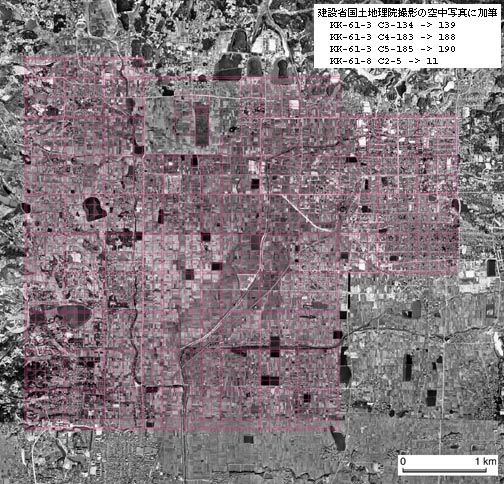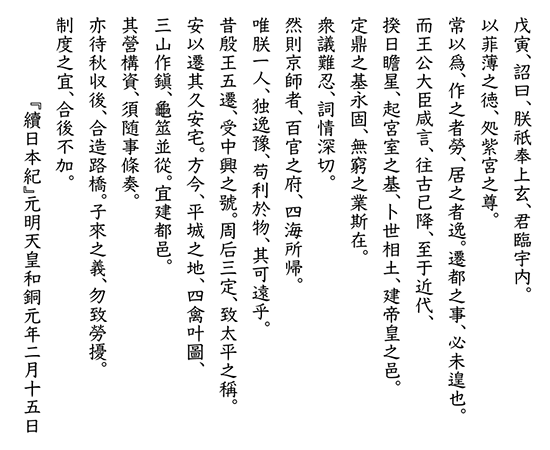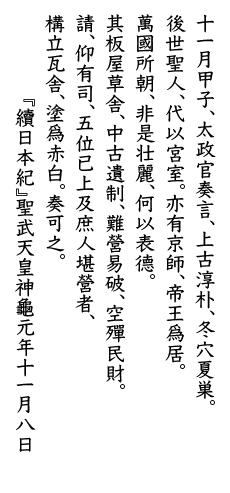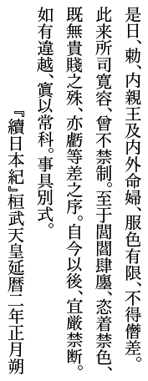Nara (Heijō-kyō) — The Capital of Japan in the 8th Century


Mosaicked aerial photo over the site of the ancient capital Nara.
Enlarged image (305Kbytes)
Photo by the Geographical Survey Institute of Japan (mosaicked
and retouched).
| |
With the beauty of green (tiled roofs)
and vermilion (pillars),
The imperial city of Nara is now in its glory,
Like the brilliance of flowers in full bloom. |
— By Ono-no-Oyu, Man’yō-shū No.
328. |
Man’yō-shū, Japan’s first anthology and compiled
in the 8th century, consists of about 4,500 Japanese poems. In the above poem,
Ono-no-Oyu, then the vice-governor of Dazaifu (the local authority near modern
Fukuoka, which had jurisdiction over Kyushu) thought of the prosperity of
Nara,
the capital of Japan at the time.
Nara was the capital of Japan from 710 AD to 784 AD. This period
was relatively short compared to the capital era of Kyoto, which
lasted for over a millennium. Nevertheless, it was important because
in this period Japan conducted a most active communication with
East Asian nations and established political and legal (ritsuryō)
systems by borrowing from the corresponding Chinese systems.
The following text is of the edict that decreed the transfer
of the capital, which was issued by the Japanese government (then
located in Fujiwara-kyō) in the name of Empress Gemmei on the 15th day, 2nd month, 1st year
of the Wadō Era (March 11, 708 AD by the Julian calendar). It was recorded in Shoku-Nihongi, the second official history
of Japan after Nihon-shoki, which was compiled in the last
decade of the 8th century. It reflected the influence of the geographical
idea of ancient China.
|

On the day of Wu-Yin*, an edict was issued as follows; Having accepted the heaven’s order, I hold the position of the ruler of the country. Although my virtue is not sufficient, I reside in the precious palace. I always consider people’s laboriousness in its construction while living there is easy. I cannot help feeling reluctant about transferring the capital. However, nobilities and government officials in chorus offer an opinion as follows; From ancient times on, based on astrology and geomancy, the sites of the capitals have been chosen. They had proper and lasting reasons which should not be ignored. As for the capital, it is to house one hundred divisions of the government, and the focal point that peoples from the four directions meet. It is not just the ruler’s residence. I should accept the opinion as reasonable.
In ancient
times, the kings of the Yin Dynasty** restored
their country after transferring the capital five times. The sovereigns
of the Zhou Dynasty*** ensured
peace in their country after establishing the capital three times. The
rulers of both dynasties reasonably moved their residences. Today, as
for the site of Nara, the layout of the four animals**** is in accord with the model, mountains guard the
site in three directions,***** and the divinations
suggest good fortune. We should build a new capital at this site. Materials
for construction, as the need arises, should be listed and reported.
Construction of streets and bridges should be started after the autumn
harvest so that the people who are willing to render services****** would
not be disturbed. Plans should be carefully worked out so that they would
not be changed subsequently.
* 15th day of the Chinese zodiac cycle.
** Ancient
dynasty of China, also called Shang (? ~ 11th century BC)
*** Ancient dynasty of China (11th
century BC ~ 256 BC)
**** Symbols of the four directions
in the Chinese geomancy are the Black Tortoise of the North, the
Azure
Dragon of the East, the White Tiger of the West, and the Red Bird
of the South.
***** Namely, the North, East and West.
****** Rhetoric borrowed from a Chinese classic.
Shijing, a classical Chinese anthology compiled in the Zhou
period, includes a phrase ‘Zi-lai’ (meaning ‘children
coming’) to
describe people rendering services voluntarily. In reality, of
course, those services to construct the capital were imposed upon people
as mandatory just like taxes.
|
The borrowing of systems was also reflected in the style of
city planning. The ancient capital shared with other East Asian
capitals such features as a rectangular shape and grid-patterns
for streets. This way of city planning (Jō-Bō
System) was modeled on the Chinese planning system. We can
see in the above aerial photo, taken in 1961, the traces of those
features in the street and canal patterns and square-shaped reservoirs.
However, Nara did not follow the Chinese model in every way. For
example, unlike its continental counterparts, Nara never had city
walls.
The following text included in Shoku-Nihongi mentions a decree
issued on the 8th day, 11th month, 1st year of the Jinki era (December 2, 724
AD by the Julian calendar). From this text, we realize that people of the ruling
class at the time were conscious of the importance of visual effects of the
urban landscape.
|
On
the day of Jia-Zi* in the eleventh month,
the cabinet offered a proposal to the emperor as follows; We hear that,
in ancient times, lives were so simple that people lived in caves in
winter and nests in summer. In recent years, the noble people live
in palaces instead. We also have the capital for residence of the emperor.
Since the capital is visited by people from remote provinces and foreign
countries, how can we express the virtue of the emperor if the capital
lacks magnificence? Houses roofed by wood and thatch are hangovers
from the middle ages. They are vulnerable to damage and compel useless
expenses to people. We offer a proposal to decree that the authorities
should instruct noblemen and wealthy commoners to equip their houses
with tiled roofs, vermilion pillars and white walls. The proposal was
admitted.
* First
day of the Chinese zodiac cycle.
|
|
 |
Obviously this decree was impracticable for Japanese houses at the time.
Even in the later centuries, houses with tiled roofs were rare except for Buddhist
temples and government buildings. In the screens depicting the landscape of
Kyoto (so-called Rakuchū-Rakugai-zu), we have precise images of the
capital in the 16th century. In viewing these screens, however, we find that
most of the houses of all classes are roofed by wood or thatch.
| |
Coming alone to the
Western Marketplace,
I bought a silk dress without my partner’s eyes and comments,
It’s really disappointing shopping! |
— Author
unknown, Man’yō-shū No. 1264. |
From the above poem, we can suppose that the citizens of Nara enjoyed shopping
in the official marketplaces (Eastern and Western). The
following text is the edict issued in the new year’s
day of the 2nd year of the Enryaku era (February 6, 783 AD
by the Julian calendar), which was recorded in Shoku-Nihongi.
|
On
this day, an edict was issued as follows; Colors of dresses for princesses
and court ladies are prescribed in the law according to their court
ranks, and unsuited clothes are prohibited. In these days, the authorities
have been so tolerant that they have never enforced these rules. Even
women of the commoner’s
class wear clothes of the prohibited colors freely so the
order of social status is ignored. Hereafter the rules should be enforced
strictly and the offender should be penalized by the law. Detailed
prescription is provided in another list.
|
|
 |
From the above text we can imagine that the variety of clothing materials
in the market had increased so that the authorities had become unable to control
them. Construction of road networks under the ritsuryō (legal) system
seems to have promoted production of every sort of commodities in the remote
provinces. Peace and political stability for decades had brought consumer society
to the capital. The age of Nara, however, was drawing to an end. Emperor Kammu,
the sovereign at the time, had made up his mind to transfer the capital to
renew the public feelings.
By Noboru Ogata, Emeritus, Kyoto University
Last Updated : August 11, 2024





